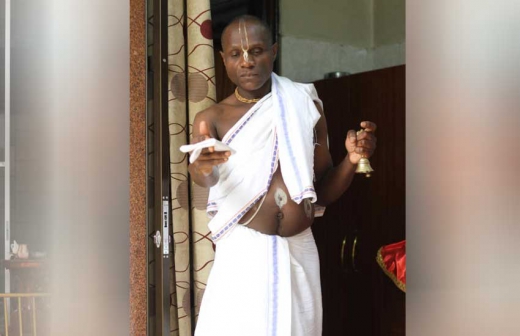
In 1971, an Indian man made his maiden voyage to Kenya. He was coming to visit his friend who had previously moved to the country. Srila Prabhupada was a sick man, and he wanted to find his rejuvenation in the oceanfront home of his friend Mr Pandya.
The calm seas gave him a beautiful healing calm, and when he got better, he decided to visit the country's capital, see what lay beyond the oceans. He also wanted to visit the Vedic devotees (Hindu practitioners), also of Indian origin.
He also wanted to preach to the Africans. Spread his devotion. And he succeeded. He developed a following. One of his devotees, impressed by the faith, bought a house in the now Parklands area, the same house that is now the imposing Hare Krishna temple.
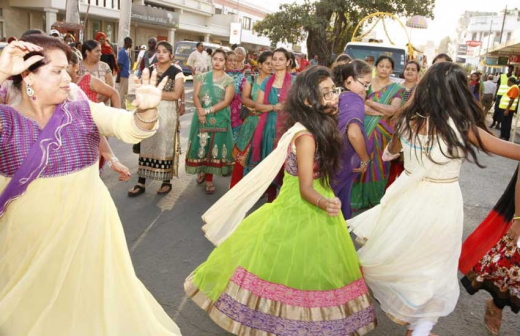
Today, the faith has spread far and wide, and there are many more similar temples in Mombasa and Kisumu.
We make our way to the Parklands landmark located on Ngara Road. It is hard to miss it despite being surrounded by apartments and business blocks.
At hand to welcome us is Rakuma Dasa. Clad in orange garb, he cuts an arresting figure. Bald headed with little beginnings of wrinkles on his face, he is what I have always imagined a monk to look like; Indian, bald, all smiles. And with a Zen attitude.
He meekly offers us his hand in greeting and motions us to follow him up a flight of stairs into a marble-tiled veranda.
"Welcome to Hare Krishna temple. Please leave your shoes here," he directs calmly, explaining that it would be sacrilege to wade into the temple with shoes.
The first thing I see are imposing statues flanking the entrance. The figures resemble humans but with four hands; spread out into the air in welcoming fashion.
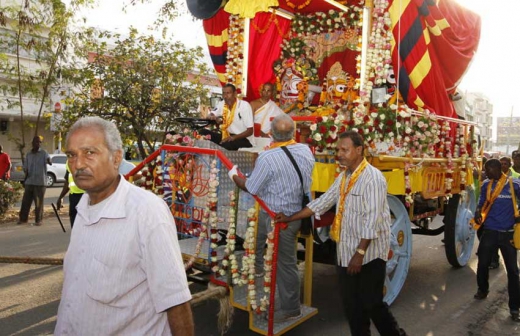
"Are these gods?" I ask curiously.
"They are not gods. They are guards. The temple represents heaven. And in heaven, according to our beliefs, guards with four hands stand on either sides of the entrance to usher souls in."
We climb farther up the stairs and I understand the representation of the temple as heaven. The floor sparkle clean and the space is filled with statues, drawings and religious artwork. On the far end is an altar; lined with statues of what one would quickly assume to be gods.
There are female monks in the temple. Dressed in coloured saris, they sit together around a table, quietly sorting flowers. It is eerily quiet. Intermittently, I spot a monk passing, headed into the inner folds of the temple.
"Come into my office," Rukuma calls us into a small room. It is inside the office that Rukuma describes, in detail, the Hare Krishna faith.
The doctrines
I soon learn that Hare Krishna movement is a branch of Hinduism who chant 'Hare Krishna' –'Hare' refers to 'praise' or 'Hail' and 'Krishna' means God and Hare Krishna faithful believe in the existence of one Supreme Being, God, otherwise known as Krishna.
"Krishna has 330 million demigods assisting him in his work. For instance, there is a god who controls the wind. Another one controls the sun. There is a god in charge of the blinking of the human eye while another oversees the act of chewing food. Simply put, there is a god for everything.

In total, 330 million gods exist to control life as we know it," Rukuma says. The monks dedicate their lives to serving Krishna.
"Being a monk means giving your life to the service of God," he says.
While the faithful are allowed to lead a normal life – holding a job to earn a living – monks are expected to give God all of their time.
"A monk is always serving Krishna. They clean the temple. They go out to preach to faithful. They visit congregants who come to pray at the temple. They pray for the sick. They chant praises to Krishna. And they live within his laws," explains Rukuma.
Hare Krishna faithful derive wisdom, knowledge and beliefs from Bhagavad Gita. The Bhagavad Gita is to Hare Krishna practitioners what the Bible is to Christians.
This notwithstanding, Hare Krishna understanding is that when Hindus pray to Krishna, or when members of the Abrahamic faith pray to Allah or Yahweh, we are all praying to one and the same person.
A sexless life
According to the Bhagavad Gita, a Hare Krishna monk can marry (if that is their wish). However, they can only practice procreative sex.
"Sex for purposes other than producing children makes us more materialistic and slows our spiritual growth," says Rukuma, who became a monk in 1982.
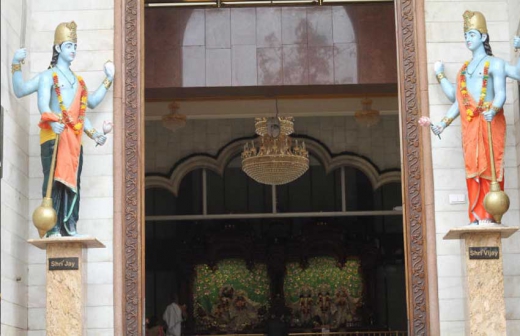
Essentially, engaging in sex just for pleasure is strongly discouraged.
Rukuma stopped having sex in 1985. "That is the year my wife and I had our third child," he says. Rukuma's desire was to have three children. And having reached the milestone he had no more reason to engage in further carnal interactions. They have three children; two daughters and a son. They are adults now and living away from the temple. His wife, is not a monk but lives in the temple.
Progressive religion
Krishna, the supreme God, is often accompanied by Radharani, the Supreme Goddess. The Hare Krishna faith has been touted as progressive; affording women as much equality to men as possible.
Both men and women can be monks in the Hare Krishna faith. Both men and women can become priests too. The rules therefore apply across the divide.
Typically, female monks spot long hair. Male monks shave their heads but leave out a single lock of hair in the back called sikha.
"This is because we believe that when one dies the soul is delivered through this lock of hair," Rukuma says.
Why shave? I prod.
Shaving hair is a symbol of cleanliness. Cleanliness is also promoted by showering twice every 24 hours: before the first prayer of the day, at 4.30am, and before afternoon prayers at 3.30pm. Hare Krishna monk is further taught to be simple (to shun materialism) in their dressing.
A female monk wears a sari while a male monk adorns a robe – or ties a garment around their body called dhoti.
The Hare Krishna temple in Nairobi currently houses 16 monks. Each monk has a cubicle while others share. The monks cook for themselves. They divide their daily chores in the temple among themselves.
No meat diet
Being merciful is not limited to human-to-human interactions. Animals too are beings. Humans are therefore asked to steer clear of harming animals as this is interpreted as violence against a being.
"Meat is a product of violence," Rukuma points out. "Our diet is largely vegetarian." But they will drink milk or eat milk products like cheese.
Rukuma explains that unlike meat, milk is not a product of violence. "You don't need to kill an animal to get milk. That is the difference."
Interestingly breaking an egg, say, to make an omelette, is violence against a being. Plant based foods are also held to a higher status in the Hare Krishna faith because they have an innate ability to continue propagation. "If you pluck a mango fruit from its tree, you haven't killed the tree: the tree will continue to grow. Plus, plants can regenerate from seeds, or even parts of the plant."
Shunning materialism
"Our lives are dedicated to God. That is why we adhere to as much simplicity, to keep our minds focussed on God, and not materials of the world," Rukuma says.
But monks are not followed around to be held to their pledge of servitude. "It is upon you, as a monk, to identify what destroys you. You ought to be honest with yourself.
Then decide to do something: shunning it if it makes you materialistic and taking it up if it serves Krishna," Rukuma says.
The monk from Siaya
Peter Mwamba, a priest at the Nairobi Hare Krishna temple, joined the faith in a quest for a more meaningful life.
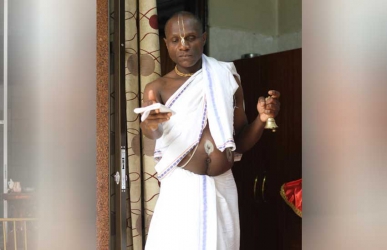
"I joined in 1999 here in Nairobi," he says. "I was a Christian – but only by name." Peter says he lived the treacherous life of a drunkard and a sex-crazed maniac, "Just like most men do."
He had bumped into the faith while searching for a religion that would bring him more understanding, having tried Islam before.
Three years of learning scripture followed before Peter was initiated into monkhood. He was assigned a spiritual master (all Hare Krishna monks have a spiritual master), who renamed him Padmalocana Dasa.
Peter too is married, and after feeling satisfied that he had had enough children, stopped having sex. His wife and three children live away from the temple and to support themselves, his wife runs a business.
"Of course a sexless life is not as easy as it sounds," he says, "because it is a life that you ease into with time as your faith grows stronger."
In most part, a Hare Krishna monk spends so much of his time chanting mantra – either silently (when alone) or audibly (in a group).
'Mantra' means to free the mind. And in Hare Krishna, the mantra goes as follows: Hare Krishna, Hare Krishna, Krishna Krishna, Hare Hare Hare Rama, Hare Rama, Rama Rama, Hare Hare Often, Hare Krishna monks will spot a pouch hanging from their neck.
The monks carry a string of beads inside the pouch. Beads are used to chant the Hare Krishna mantra.
Concept of the Catholic Rosary
The bead is held in one hand and fingered in a circle – one bead touched for every repetition of mantra.
In the best seller Eat, Pray, Love, by Elizabeth Gilbert, the author captures the history behind the use of beads in worshiping God.
From her research, Gilbert documents that when medieval crusaders travelled east for the holy wars, they witnessed worshippers praying with a string of beads (referred to as japa malas). They then carried the idea back to Europe, into Catholicism, as rosary.
A monk's string of beads has 108 beads. "The number 108 is believed to be the most auspicious," Rukuma says.
 The Standard Group Plc is a multi-media organization with investments in media
platforms spanning newspaper print
operations, television, radio broadcasting, digital and online services. The
Standard Group is recognized as a
leading multi-media house in Kenya with a key influence in matters of national and
international interest.
The Standard Group Plc is a multi-media organization with investments in media
platforms spanning newspaper print
operations, television, radio broadcasting, digital and online services. The
Standard Group is recognized as a
leading multi-media house in Kenya with a key influence in matters of national and
international interest.
